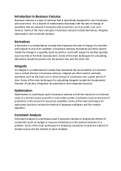NURS 5315 GI Module 9, exam 5
Upper GI organs - ANSmouth,pharynx, esophagus, stomach, and duodenum
Lower GI organs - ANSsmall intestine, large intestine, rectum and anus
Hepatoportal circulation - ANShepatic artery receives oxygenated blood from the inferior
mesenteric, gastric, and cystic veins. The hepatic portal vein receives deoxygenated blood from
the inferior and superior mesenteric vein and splenic vein and delivers nutrients that have been
absorbed from the intestinal system
Osmotic diarrhea - ANSCaused by the presence of a nonabsorbable substance in the
intestines. This pulls water by osmosis into the intestinal lumen and results in large volume
diarrhea. This is how mag citrate, lactulose and miralax work. Causes include: excessive
ingestion of nonabsorbable sugars, tube feedings, dumping syndrome, malabsorption,
pancreatic enzyme deficiency, bile salt deficiency, small intestine bacterial overgrowth or celiac
disease
Secretory diarrhea - ANSResults in large volume losses secondary to infectious causes such as
rotavirus, bacterial enterotoxins, or c-diff.
Motility diarrhea - ANSAKA short bowel syndrome. Results from resection of small intestine or
surgical bypass of small intestine, IBS, diabetic neuropathy, hyperthyroidism, and laxative
abuse. Fatty stools and bloating are common in malabsorption syndrome. Complications
include: dehydration, electrolyte imbalance, metabolic acidosis, weight loss and malabsorption.
Upper GI bleed - ANSbleeding that occurs in the esophagus, stomach or duodenum commonly
caused by bleeding varices, peptic ulcers or Mallory-Weiss tear(tearing of esophagus from
stomach) Characterized by frank, bright red or coffee ground emesis.
Lower GI bleed - ANSBleeding in the jejunum, ileum, colon or rectum from inflammatory bowel
disease, cancer, diverticula or hemorrhoids. Hematochezia, or the presence of bright red blood
in the stools, suggest what kind of bleed
Peptic Ulcer Disease - ANSIs a break in the integrity of the mucosa of the esophagus, stomach
or duodenum resulting in exposure of the tissue to gastric acid. Risk factors include smoking,
advanced age, NSAID use, ETOH, chronic disease, acute pancreatitis, COPD, obesity,
socioeconomic status, gastrinoma, and infection with Helicobacter pylori. S&S: Epigastric pain is
worse with eating, melena or hematemesis
Duodenal ulcers - ANSmost common and tend to develop in younger patients. S&S: epigastric
pain that is relieved by food. Patients may have melena(black and tarry stool) or hematemesis
, Ulcerative colitis (UC) - ANSInflammatory disease of the large instestine in persons 20-40y/o.
Less common in people who smoke. Has periods of remission and exacerbations.
Characterized by inflammation and ulcerations that remain superficial and in the small intestine.
UC S&S - ANSrecurrent diarrhea, bloody stools, febrile, polyarthritis, uveitis, sclerosing
cholangitis, erythema nodosum and pyoderma gangrenosum
UC complications - ANSfissures, hemorrhoids, perirectal abscess, toxic megacolon, colon
perforation, and colorectal adenocarcinoma. Increased risk of VTE and microthrombi, and colon
cancer
Crohn's disease - ANSChronic inflammatory disorders that can affect any portion of the GI tract
but most often in the ileum and proximal colon. Affects persons in their 20-30s and of jewish
decent. CARD15/NOD2 gene mutation commonly associated.
Crohn's disease risk factors - ANSsmoking, family history, Jewish decent, age less than 40,
slight predominance in women and altered gut microbiome.
Crohn's disease patho - ANSincludes trasmural involvement of the affected area(entire wall of
intestine is affected) and the presence of skip lesions. Disease progression may lead to abscess
formation in GI tract. Possible causes include infectious agents, autoimmune, psychosomatic,
impaired T-cell immunity
Crohn's disease S&S - ANSabd pain, diarrhea, dehydration, bloody stools, malabsorption,
malnutrition, weight loss, intestinal obstruction from chronic inflammation, fistulas and
perforation of the intestine
Diverticular disease - ANSCharacterized as the presence of diverticula in the large intestine.
Risk factors include older age, genetic predisposition, obesity, smoking, diet, lack of exercise,
ASA and other NSAIDS, altered DI microbiome and abnormal colonic peristalsis
Diverticulosis/Diverticulitis - ANSoutpouchings of mucosa from the muscle layer of the intestine
that protrude into the intestinal lumen most commonly in the sigmoid colon. Diverticulosis is the
presence of diverticula in an asymptomatic person. Diverticulitis is an inflammation of diverticula
and cause LLQ pain. Results in abscess formation, rupture and peritonitis
Appendicitis - ANSInflammation of the appendix usually in persons 10-19. S&S: periumbilical
pain, RLQ pain, nvd, anorexia. Pain may initially be epigastric or periumbilical then settle in
RLQ. Perforation, peritonitis and abscess formation are all potential complications
Small bowel obstruction - ANSMost commonly caused by postop adhesions, tumors, Crohn's
disease, hernias and intussusception. Causes distention 2ndary to impaired absorption and











